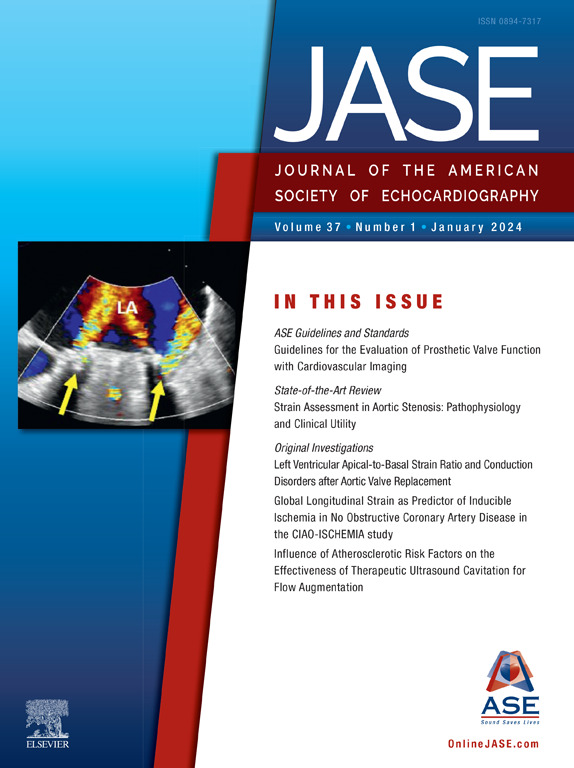Lung Ultrasound Density Score Index Performed With Cardiopulmonary Exercise Echocardiography Testing Is Associated With Impaired Exercise Capacity
IF 6
2区 医学
Q1 CARDIAC & CARDIOVASCULAR SYSTEMS
Journal of the American Society of Echocardiography
Pub Date : 2025-10-01
DOI:10.1016/j.echo.2025.07.005
引用次数: 0
Abstract
Background
Exercise stress echocardiography and cardiopulmonary exercise testing (CPET) are frequently used for the evaluation of patients with dyspnea and exercise intolerance. Lung ultrasound (LUS) has been shown to increase the prognostic utility of stress echocardiography. Integration of LUS into stress echocardiography for undifferentiated ambulatory patients undergoing clinically indicated simultaneous CPET has not been previously evaluated.
Objectives
To determine whether LUS, when performed immediately before and after exercise testing, is associated with reduced exercise capacity, as defined by peak oxygen consumption (O2peak), in patients undergoing clinically indicated stress echocardiography with CPET.
Methods
Lung ultrasound performed pre- and postexercise in a retrospective cohort of 261 consecutive patients with normal left ventricular ejection fraction undergoing simultaneous stress echocardiography and CPET. Lung ultrasound was performed in 4 lung zones, and a semiquantitative assessment of B-line burden was accomplished using the novel LUS density score index (LUDSI).
Results
Lung ultrasound was feasible in 100% of patients pre- and postexercise. An LUDSI ≥0.5 was associated with impaired exercise capacity (O2peak of <90% predicted) at rest (area under the curve [AUC] = 0.75) and poststress (AUC = 0.76) after adjusting for age and sex. The association of LUDSI ≥0.5 and impaired exercise capacity was only incrementally improved with the integration of diastolic function (E/e’) performed at rest (AUC = 0.77) and poststress (AUC = 0.78).
Conclusions
The LUDSI is a simple and highly feasible measure of B-line burden that can be performed pre- and postexercise. A LUDSI ≥0.5 was associated with impaired exercise capacity in patients with normal left ventricular ejection fraction undergoing simultaneous stress echocardiography and CPET.
心肺运动超声心动图检查肺超声密度评分指数与运动能力受损有关。
背景:运动应激超声心动图和心肺运动试验(CPET)常用于评估呼吸困难和运动不耐受患者。肺超声(LUS)已被证明可以增加应激超声心动图的预后效用。对于接受临床指示的同时进行CPET的未分化门诊患者,将LUS整合到应激超声心动图中尚未进行评估。目的:确定在接受临床指示的CPET应激超声心动图检查的患者,在运动试验前后立即进行LUS是否与运动能力降低有关,以峰值耗氧量(V˙o2峰值)来定义。方法:LUS对261例左室射血分数(LVEF)正常的连续患者进行了运动前和运动后的回顾性队列研究,同时进行了应激超声心动图和CPET。采用新型肺超声密度评分指数(LUDSI)对4个肺区进行LUS检查,并对b线负荷进行半定量评估。结果:LUS在运动前和运动后100%可行。LUDSI≥0.5与运动能力受损相关(V˙o2峰值)
本文章由计算机程序翻译,如有差异,请以英文原文为准。
求助全文
约1分钟内获得全文
求助全文
来源期刊
CiteScore
9.50
自引率
12.30%
发文量
257
审稿时长
66 days
期刊介绍:
The Journal of the American Society of Echocardiography(JASE) brings physicians and sonographers peer-reviewed original investigations and state-of-the-art review articles that cover conventional clinical applications of cardiovascular ultrasound, as well as newer techniques with emerging clinical applications. These include three-dimensional echocardiography, strain and strain rate methods for evaluating cardiac mechanics and interventional applications.

 求助内容:
求助内容: 应助结果提醒方式:
应助结果提醒方式:


